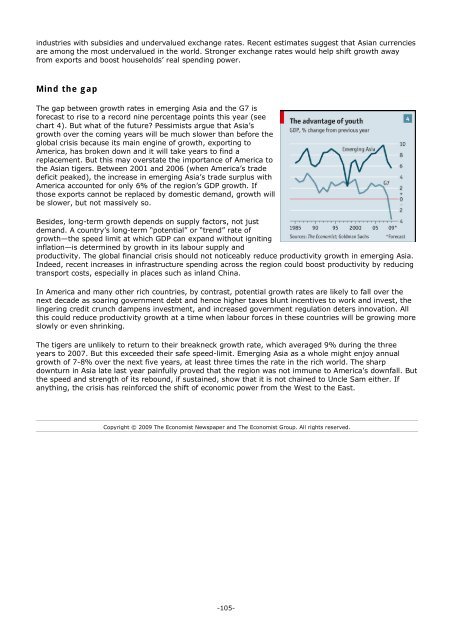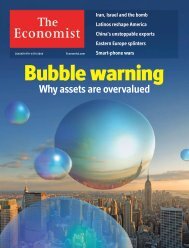Untitled - the ultimate blog
Untitled - the ultimate blog
Untitled - the ultimate blog
Create successful ePaper yourself
Turn your PDF publications into a flip-book with our unique Google optimized e-Paper software.
industries with subsidies and undervalued exchange rates. Recent estimates suggest that Asian currencies<br />
are among <strong>the</strong> most undervalued in <strong>the</strong> world. Stronger exchange rates would help shift growth away<br />
from exports and boost households’ real spending power.<br />
Mind <strong>the</strong> gap<br />
The gap between growth rates in emerging Asia and <strong>the</strong> G7 is<br />
forecast to rise to a record nine percentage points this year (see<br />
chart 4). But what of <strong>the</strong> future? Pessimists argue that Asia’s<br />
growth over <strong>the</strong> coming years will be much slower than before <strong>the</strong><br />
global crisis because its main engine of growth, exporting to<br />
America, has broken down and it will take years to find a<br />
replacement. But this may overstate <strong>the</strong> importance of America to<br />
<strong>the</strong> Asian tigers. Between 2001 and 2006 (when America’s trade<br />
deficit peaked), <strong>the</strong> increase in emerging Asia’s trade surplus with<br />
America accounted for only 6% of <strong>the</strong> region’s GDP growth. If<br />
those exports cannot be replaced by domestic demand, growth will<br />
be slower, but not massively so.<br />
Besides, long-term growth depends on supply factors, not just<br />
demand. A country’s long-term “potential” or “trend” rate of<br />
growth—<strong>the</strong> speed limit at which GDP can expand without igniting<br />
inflation—is determined by growth in its labour supply and<br />
productivity. The global financial crisis should not noticeably reduce productivity growth in emerging Asia.<br />
Indeed, recent increases in infrastructure spending across <strong>the</strong> region could boost productivity by reducing<br />
transport costs, especially in places such as inland China.<br />
In America and many o<strong>the</strong>r rich countries, by contrast, potential growth rates are likely to fall over <strong>the</strong><br />
next decade as soaring government debt and hence higher taxes blunt incentives to work and invest, <strong>the</strong><br />
lingering credit crunch dampens investment, and increased government regulation deters innovation. All<br />
this could reduce productivity growth at a time when labour forces in <strong>the</strong>se countries will be growing more<br />
slowly or even shrinking.<br />
The tigers are unlikely to return to <strong>the</strong>ir breakneck growth rate, which averaged 9% during <strong>the</strong> three<br />
years to 2007. But this exceeded <strong>the</strong>ir safe speed-limit. Emerging Asia as a whole might enjoy annual<br />
growth of 7-8% over <strong>the</strong> next five years, at least three times <strong>the</strong> rate in <strong>the</strong> rich world. The sharp<br />
downturn in Asia late last year painfully proved that <strong>the</strong> region was not immune to America’s downfall. But<br />
<strong>the</strong> speed and strength of its rebound, if sustained, show that it is not chained to Uncle Sam ei<strong>the</strong>r. If<br />
anything, <strong>the</strong> crisis has reinforced <strong>the</strong> shift of economic power from <strong>the</strong> West to <strong>the</strong> East.<br />
Copyright © 2009 The Economist Newspaper and The Economist Group. All rights reserved.<br />
-105-








![[ccebbook.cn]The Economist August 1st 2009 - the ultimate blog](https://img.yumpu.com/28183607/1/190x252/ccebbookcnthe-economist-august-1st-2009-the-ultimate-blog.jpg?quality=85)



![[ccebook.cn]The World in 2010](https://img.yumpu.com/12057568/1/190x249/ccebookcnthe-world-in-2010.jpg?quality=85)
![[ccemagz.com]The Economist October 24th 2009 - the ultimate blog](https://img.yumpu.com/5191885/1/190x252/ccemagzcomthe-economist-october-24th-2009-the-ultimate-blog.jpg?quality=85)